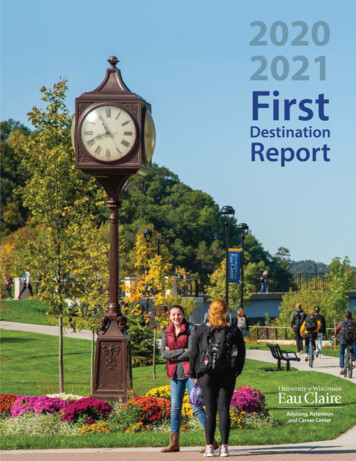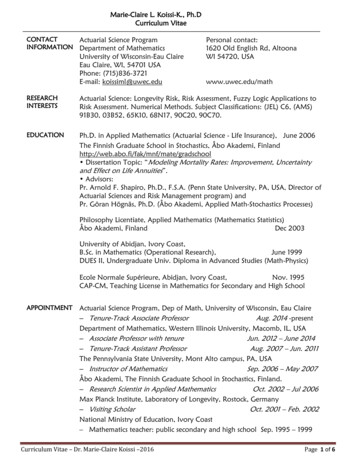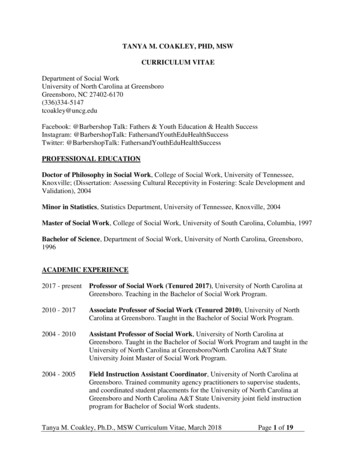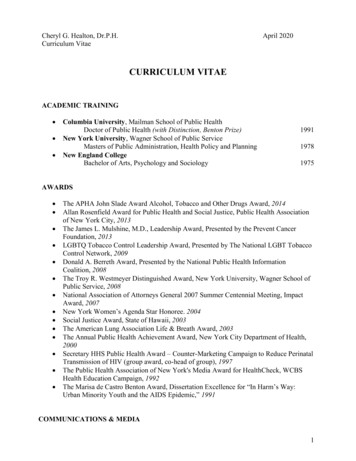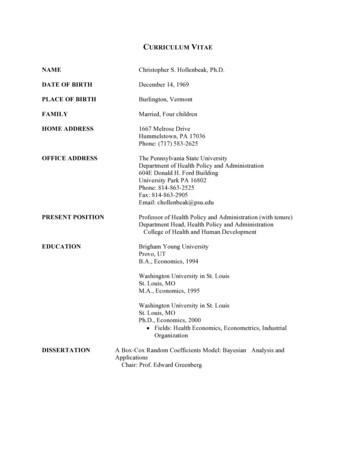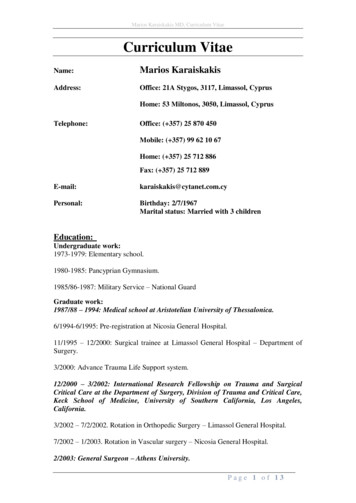
Transcription
CURRICULUM VITAEClaire E. SterkCharles Howard Candler Professor of Public HealthUniversity President, EmeritaEmory UniversityOffice Address:Emory University1599 Clifton RD NE.Atlanta, GA 30322Phone: (404-727-6788e-mail: clairesterk@emory.eduHigher Education:Erasmus University, Rotterdam (the Netherlands); PhD (1990); SociologyUniversity of Utrecht, Utrecht (the Netherlands); Doctorandus (1983); Medical/UrbanAnthropologyVrije Universiteit (Free University), Amsterdam (the Netherlands); Kandidaats (1979);Propadeuse (1977); Cultural Anthropology/ Non-Western SociologyExecutive and Administrative Positions:President, Emerita, Emory University, 2020- presentPresident, Emory University, 2016-2020Provost and Executive Vice President for Academic Affairs, Emory University, 2013 - 2016Acting Provost and Executive Vice President for Academic Affairs, Emory University, 2012-2013Senior Vice Provost for Academic Affairs, Emory University, 2005-2012Founding Director, Center for Faculty Development and Excellence, Emory University, 20102012Associate Dean for Research, Rollins School of Public Health, Emory University, 2004-2005Chair, Department of Behavioral, Social, and Health Education Sciences, Rollins School ofPublic Health, Emory University, 2000-2005(Acting) Director and Associate Director, Women’s and Children’s Center, Rollins School ofPublic Health, Emory University, 1995-1997Director, Center for Applied Research in Anthropology, Georgia State University, 1990-1995Visiting Scientist, Centers for Disease Control, Center for Prevention Services, 1988-1990Director of Research, Department of Education, Stichting Opleiding en Vorming Detailhandel,the Netherlands, 1985-1986Faculty Positions:Charles Howard Candler Professor in Public Health, Rollins School of Public Health, EmoryUniversity, with secondary appointments in Emory College of Arts and Sciences and EmorySchool of Medicine, 2000 - presentProfessor of Behavioral, Social, and Health Education Sciencesm 2000-; Associate Professor,1995-2000; Rollins School of Public Health, Emory University
Associate Professor and Assistant Professor, Department of Anthropology, Georgia StateUniversity, 1990-1995Faculty Member, Erasmus University, School of Medicine, Institute for Preventive and SocialPsychiatry, Rotterdam, the Netherlands, 1986-1988Faculty Member, University of Utrecht, Department of Sociology/Institute of Studies of MultiCultural Societies, Utrecht, the Netherlands, 1984-1986Academic Awards and Honors:Elected Member, American Academy of Arts and Sciences, 2019Elected Member, National Academy of Medicine, 2018Senior Scholar Award, Division on Alcohol, Drug and Tobacco Use, American SociologicalAssociation, 2014Senior Scholar Award, Drinking and Drugs Section, Society, Study of Social Problems, 2011Unsung Heroine Award (administrator), Center for Women, Emory University, 2011Sociologist of the Year Award, Georgia Sociological Association, 2010Rosalynn Carter Fellow in Public Policy, 2003-2006Woman of the Year nomination, Atlanta Woman Magazine, 2003Distinguished Faculty Lecturer, Emory University, 2003Mary Lynn Morgan Lecturer in Women’s Health, Emory University, 2002Great Teachers Lecturer, Emory University, 2000Thomas F. Sellers Jr. Award, Rollins School of Public Health, Emory University, 1999Fellow, Society for Applied Anthropology, 1996- presentOutstanding Junior Faculty Award, Georgia State University, 1994Scholarship Award, Women and Science Association, Amsterdam, the Netherlands, 1982Publications:BooksSterk, C. (2000). Tricking and tripping: Prostitution in the era of AIDS. Putnam Valley, NY: SocialChange Press.Sterk, C. (1999). Fast lives: Women who use crack cocaine. Philadelphia: Temple University Press.Sterk, C. (1984). Vieze kereltjes: Zedenpolitie en vrouwen (Vice squad and women: organizationalchallenges). IJmuiden: Koninklijke Vermande B.V.Selected Articles:126. Yeager, K, Quest, T., Vena, C and Sterk, C. (2018). Living with symptoms: A aualitativestudy of black adults with advanced cancer living in poverty. Pain Management Nursing19(1), 34-45.125. Yeager, K., Sterk, C., Quest, T. (2016). Managing one’s symptoms: A qualitative study oflow-income African Americans with advanced cancer. Cancer Nursing 39(4): 303-312.124. Steidl, Christina and Sterk, C. (2016). Interpreting Productivity: Symbolic Negotiationof Gendered Faculty Career Trajectories in the United States. Symbolic Interaction, 39(4):805-815.123. Klein, H., Sterk, C. and Elifson, K. (2016). Knowledge about HIV in a community sample2
122.121.120.119.118.of urban African Americans in the South. Journal of AIDS & Clinical Research,7(10): 1000622.Elifson, K., Klein, H., and Sterk, C. (2016). The value of using a syndemics theoryconceptual model to understand the factors associated with obesity in a southern, urbancommunity sample of disadvantaged African-American adults. The Journal of the NationalBlack Nurses Association, 27(1): 1-10.Klein, H., Elifson, K., and Sterk, C. (2016) How the interaction of childhood sexualabuse and gender relates to HIV risk practices among urban-dwelling AfricanAmericans. Journal of AIDS and HIV Infections, 2(1): 1-14.Hynes, M., DePadilla, L., McCarty, F., Sterk, C., Hennink, M. and Yount, K. (in press).Women’s relative schooling advantage and intimate partner violence in Colombia.Violence against Women.Nehl, E., Klein, H., Sterk, C., and Elifson, K. (2016). Prediction of HIV sexual riskbehaviors among disadvantaged African American adults using a syndemic conceptualframework. AIDS Behavior, 20(2): 449-460.Hynes, M., Sterk, C., Hennink, M., Patel, S., DePadilla, L. and Yount, K. (2016). Exploringgender norms, agency and intimate partner violence among displaced Colombian women:A qualitative assessment. Global Public Health, 11(2): 17-33.117. Walker, E., Borba, C., McGee, R. and Sterk, C. (2015). A dyadic model of living withepilepsy based on the perspective of adults with epilepsy and their support persons.Epilepsy and Behavior 53: 1-9.116. Nehl, E., Elifson, K., DePadilla, L., and Sterk, C. (2015). Sex partner type, drug use andcondom use self-efficacy among African Americans from disadvantagedneighborhoods: Are associations with consistent condom use moderated by gender?The Journal of Sex Research, 1-11.115. Head, S., Yount, K., Hennink, M., Sterk, C. (2014). Customary and ContemporaryResources for women’s empowerment in Bangladesh. Development in Practice, 25(11) 360374.114. Christofides, N., Jewkes, Rachel., Dunkle, F., Nwabisa Jama Shai, M., and Sterk, C. (2014).Risk factors for unplanned and unwanted teenage pregnancies over two years of followup among a cohort of young South African women. Global Health Action, 7: 1-9.113. Borba, C., McGee Robin, and Sterk, C. (2014) Perspectives of adults with epilepsy andtheir support persons on self-management support. Qualitative Health Research 24(11)1553-1566.112. Sterk, C., Elifson, K. and DePadilla, L. (2014). Neighbourhood structural characteristicsand crack cocaine use: Exploring the impact of perceived neighbourhood disorder on useamong African Americans. International Journal of Drug Policy, 25(3): 616-623.111. Christofides, N., Jewkes, R., Dunkle, K., Mzikazi, N., Nwabisa, J. and Sterk, C. (2014).Early adolescent pregnancy increases risk of incident HIV infection in the Eastern Cape,South Africa: a prospective study. Journal of the International AIDS Society, 17:18585.110. Young, A., DiClemente, R., Halgin, D., Sterk, C., and Havens, J. (2014) Drug users'willingness to encourage social, sexual, and drug network members to receive an HIVvaccine: A social network analysis. AIDS and Behavior, 18(9), 1753-1763.3
109. Young, A., DiClemente, R., Halgin, D., Sterk, C., and Havens, J. (2014) HIV vaccineacceptability among high-risk drug users in Appalachia: A cross-sectional study. BMCPublic Health 2014, 14:537.108. Elifson, K., Klein, H., and Sterk, C. (2014). Smoke and Mirrors: the perceived benefits ofcontinued tobacco use among current smokers. Health Psychology Research, 2(2): 78-84.107. Christofides, N., Jewkes, R., Dunkle R., Nwabisa Jama Shai, M., and Sterk, C.(2014). Perpetration of physical and sexual abuse and subsequent fathering of pregnanciesamong a cohort of young South African men: a longitudinal study. BMC Public Health,14.106. Walker, E., Engelhard, G., Borba, C., McGee, R., Sterk, C., DiIorio, C. and Thompson, N.(2014). A mixed methods analysis of support for self-management behaviors: Perspectivesof people with epilepsy and their support providers. Epilepsy & Behavior, 31: 152-159.105. Klein, H., Sterk, C., and Elifson, K. (2013). Initial Smoking Experiences and CurrentSmoking Behaviors and Perceptions among Current Smokers. J. of Addiction, 2013: 1-9.104. DePadilla, L., Elifson, K. and Sterk, C. (2013). Beyond sexual partnerships: The lack ofcondom use during vaginal sex with steady partnerships. International Public HealthJournal, 4(4): 435-446.103. Young, A., DiClemente, R., Halgin, D., and Sterk, C. (2013) Will HIV vaccination reshapeHIV risk behavior networks? A social network analysis of drug users’ anticipated riskcompensation. AIDS Research and Human Retroviruses, (29(11): A114.102. Borba, C., DePadilla, L., McCarty, F., von Esenwein, S. Druss, B. and Sterk, C. (2012). Aqualitative study examining the perceived barriers and facilitators to medical healthcareservices among women with a serious mental illness. Women’s Health Issues, 22(2): 217224.101. McCarty, F., DePadilla, L., Elifson, K. and Sterk, C. (2012). Excessive drinking amongAfrican American men: Individual and contextual correlates. Journal of Ethnicity inSubstance Abuse, 11(2): 113-129.100. Borba, C., DePadilla, L. Druss, B, McCarty, F., von Esenwein, S. and Sterk, C. (2011). Aday in the life of women with a serious mental illness: A qualitative investigation.Women’s Health Issues, 21(4): 286-292.99. DePadilla, L., Perkins, M., Elifson, K. and Sterk, C., (2012). Adult criminal involvement: Across-sectional inquiry into correlates and mechanisms over the life course. CriminalJustice Review, 37(1): 110-126.98. Sterk, C., Klein, H. and Elifson, K. (2011). The relationship between sexual coping and thefrequency of sexual risk among ‘at risk’ African American women. Women’s Health &Urban Life, 10: 56-80.97. Reitzes, D., DePadilla, L., Sterk, C. and Elifson, K. (2010). A symbolic interaction approachto cigarette smoking: Smoking frequency and the desire to quit smoking. Sociological Focus43(3): 193-213.96. Klein. H. Elifson, K. and Sterk, C. (2010). Self-esteem and HIV risk practices among youngadult ecstasy users. Journal of Psychoactive Drugs, 42(4): 447-456.95. Perkins, M., Elifson, K. and Sterk, C. (2010). Drug risk: A cross-sectional exploration ofthe influence of family-of-origin and current situational circumstances. Journal of DrugIssues, 40(2): 353-378.4
.Elifson, K., Klein, H. and Sterk, C. (2010). Predictors of unsafe sex among at-riskheterosexual women. Women’s Health & Urban Life, 9(2): 80-106.Elifson, K., Klein, H. and Sterk C. (2010) “Factors associated with condom use amongyoung adult ecstasy users.” International Journal of Public Health, 55(6): 571-579.Elifson, K., Klein, H. and Sterk, C. (2010) “Young adult ecstasy users who foregonecessary medical care: A fairly common occurrence with important health implications.”Journal of Psychoactive Drugs, 42(1): 63-71.Owen-Smith, A., Sterk, C., McCarty, F., Hankerson-Dyson, D. and DiClemente, R. (2010).The development and evaluation of a complementary and alternative medicine use surveyin African-Americans with Acquired Immune Deficiency Syndrome. Journal of Alternativeand Complementary Medicine, 16(5), 569-577.Carlson, R., Singer, M., Stephens, R., and Sterk, C. (2009). Reflections on 40 years ofethnographic drug abuse research: Implications for the future. Journal of Drug Issues, 39:57-70.Klein, H., Elifson, K. and Sterk, C. (2009). Young adult ecstasy users’ enhancement of theeffects of their ecstasy use. Journal of Psychoactive Drugs, 41(2): 113-120.Bahora, M., Sterk, C. and Elifson, K. (2009). Understanding recreational ecstasy use in theUnited States: A qualitative inquiry. International Journal of Drug Policy, 20(1): 62-69.Theall, K. P., Sterk, C. and Elifson, K. (2009). Perceived neighborhood fear and drug useamong young adults. American Journal of Health Behavior, 33 (4): 353-365.Shuster, J., Sterk, C., Frew, P. and Del Rio, C. (2009). The cultural and community-levelacceptance of antiretroviral therapy (ART) among traditional healers in Eastern Cape,South Africa. Journal of Community Health, 34(1): 16-22.Polensek, S., Tusa, R. and Sterk, C. (2009). The challenges of managing vestibulardisorders: a qualitative study of clinicians' experiences associated with low referral ratesfor vestibular rehabilitation. International J. of Clinical Practice, 63 (11), pp. 1604-12.Klein, H., Elifson, K. and Sterk, C. (2008). Depression and HIV risk behavior practicesamong at risk women. Women & Health, 48(2): 167-88.Elifson, K., Klein, H. and Sterk, C. (2008). Condom use self-efficacy among young adultecstasy users. Journal of Drug Issues 38(4): 981-1001.Boeri, M., Sterk, C. and Elifson, K. (2008). Reconceptualizing early and late onset: a lifecourse analysis of older heroin users. Gerontologist, 48(5): 637-45.Sterk, C., Klein, H, and Elifson, K. (2008). Young adult ecstasy users and multiple sexualpartners: Understanding the factors underlying this HIV risk practice. Journal ofPsychoactive Drugs, 40(3): 237-244.Boeri, M., Sterk, C., Bahora, M. and Elifson, K. (2008). Poly-drug use among ecstasy users:Separate, synergistic, and indiscriminate patterns. Journal of Drug Issues, 38(2): 517-542.Polensek, S., Sterk, C. and Tusa, R. (2008). Screening for vestibular disorders: A study ofclinicians' compliance with recommended practices. Medical Science Monitor, 14(5): 238242.Elifson, K., Sterk, C. and Theall, K. (2007). Safe living: The impact of unstable housingconditions on HIV risk reduction among female drug users. AIDS and Behavior, 11:S45-55.5
.60.59.Lende, D. H., Leonard, T., Sterk, C. and Elifson, K. (2007). Functional methamphetamineuse: The insider’s perspective. Addiction Research and Theory, 15(5): 465-477.Dew, B. J., Elifson, K. and Sterk, C. (2007). Differences in HIV sexual risk behaviorbetween heterosexual and non-heterosexual male users of methamphetamine. Journal ofDrug Issues, 37(2): 281-298.Sterk, C., Elifson, K. and Theall, K. (2007). Individual action and community context: Thehealth intervention project. American Journal of Preventive Medicine, 32(6S): 177-181, 2007.Sterk, C., Theall, K. and Elifson, K. (2007). Getting into ecstasy: Comparing moderate andheavy young adult users. Journal of Psychoactive Drugs, 39(3): 103-114.Reid, L., Elifson, K. and Sterk, C. (2007). Ecstasy and gateway drugs: Initiating the use ofecstasy and other drugs. Annals of Epidemiology, 17(1): 74-80.Reid, L., Elifson, K. and Sterk, C. (2007). Hug drug or thug drug?: Ecstasy use andaggressive behavior. Violence and Victims, 22(1): 104-119.Theall, K., Elifson, K., Sterk, C. and Steward E. (2007). Criminality among female drugusers following an HIV risk-reduction intervention. Journal of Interpersonal Violence, 22(1):85-107, 2007.Klein, H., Elifson, K. and Sterk, C. (2007). Childhood neglect and adulthood involvementin HIV-related risk behaviors. Child Abuse and Neglect, 31(1): 39-53.Bruehl, A. M., Lende, D. H., Schwartz, M., Sterk, C. and Elifson, K. (2006). Craving andcontrol: Methamphetamine users’ narrative. Journal of Psychoactive Drugs, S3: 385-392.Elifson, K., Klein, H. and Sterk, C. (2006). Predictors of sexual risk-taking among newusers. Journal of Sex Research, 43(4): 318-327Klein, H., Elifson, K. and Sterk, C. (2006). The relationship between religiosity and druguse among ‘at risk’ women. Journal of Religion and Health, 45(1): 40-56.Dew, B., Elifson, K. and Sterk, C. (2006). Treatment implications for young adult users ofMDMA. Journal of Addictions and Offender Counseling, 26(2): 84-98.Sterk, C., Theall, K. and Elifson, K. (2006). Young adult ecstasy use patterns: Quantitiesand combinations. Journal of Drug Issues, 36(1): 201-228.Theall, K., Elifson, K. and Sterk, C. (2006). Sex, touch, and HIV risk among ecstasy users.AIDS and Behavior, 10(2): 169-178.Boeri, M., Sterk, C. and Elifson, K. (2006). Baby boomer drug users: Career phases, socialcontrol, and social learning theory. Sociological Inquiry, 76(2): 264-291.Sterk, C., Theall, K. and Elifson, K. (2006). The impact of emotional distress on HIV riskreduction among women. Substance Use and Misuse, 41(2): 157-173.Klein, H., Elifson, K. and Sterk, C. (2006). Predictors of suicidal ideation among ‘atrisk’ cocaine-using African American women. Suicide and Life-Threatening Behaviors, 36(3):336-348.Sterk, C., Theall, K. and Elifson, K. (2005). African American female drug users and HIVrisk reduction: Challenges with criminal involvement. Journal of Health Care forthe Poor and Underserved, 16(4): 89-107.Gentry, Q., Elifson, K. and Sterk, C. (2005). Aiming for more relevant HIV risk reduction:A black feminist perspective for enhancing HIV intervention for low-income AfricanAmerican women. AIDS Education and Prevention, 17(3): 238-252.6
.41.Sterk, C., Klein, H. and Elifson, K. (2004). Self-Esteem and ‘at risk’ women: Determinantsand relevance to sexual and HIV-related risk behaviors. Women & Health, 40(4): 75-92.Theall, K., Elifson, K. and Sterk, C. (2004). Past and new victimization experiences amongAfrican American female drug users who participated in an HIV risk reductionintervention. Journal of Sex Research, 41(4): 400-407.Sterk, C., Klein, H. and Elifson, K. (2004). Partner communication and HIV risk behaviorsamong ‘at risk’ women. Social and Preventive Medicine, 49: 363-374.Boeri, M., Sterk, C. and Elifson, K. (2004). Rolling beyond raves: Ecstasy use outside therave setting.” Journal of Drug Issues, 34(4): 831-860.Sterk, C., Klein, H. and Elifson, K. (2004). Predictors of condom-related attitudes among‘at risk’ women. Journal of Women’s Health, 13(6): 676-688.Elifson, K., Klein, H. and Sterk, C. (2004). Drug problems and “at risk” women’sinvolvement in HIV risk behaviors. Social and Preventive Medicine, 49(3): 198-207.Luck, P., Elifson, K. and Sterk, C. (2004). Female drug users and the welfare system: Aqualitative exploration. Drugs: education, prevention and policy, 11(2): 113-128.Stewart, E., Elifson, K. and Sterk, C. (2004). Integrating the general theory of crime into anexplanation of violent victimization among female offenders. Justice Quarterly, 21(1): 159181.Sterk, C., Theall, K. and Elifson, K. (2003). Effectiveness of a risk reduction interventionamong African American women who use crack cocaine. AIDS Education and Prevention,15(1): 15-32.Theall, K., Sterk, C., Elifson, K. and Kidder, D. (2003). Factors associated with positiveHIV serostatus among women who use drugs: Continued evidence for expanding factorsof influence. Public Health Reports, 118(5): 415-424.Sterk, C., Theall, K. and Elifson, K. (2003). Who’s getting the message? Interventionresponse rates among women who inject drugs and/or smoke crack cocaine. PreventiveMedicine, 37(2): 119-128.Sterk, C., Klein, H. and Elifson, K. (2003). Perceived condom use self-efficacy among ‘atrisk’ women. AIDS and Behavior, 7(2): 175-182Klein, H., Elifson, K. and Sterk, C. (2003). Perceived temptation to use drugs and actualdrug use among women. Journal of Drug Issues, 33(1): 161-192.Johnson, W. and Sterk, C. (2003). Late onset crack users: An emergent HIV risk group.Journal of AIDS, 33(S2): 229-232.Theall, K., Elifson, K., Sterk, C. and Klein, H. (2003). Perceived susceptibility HIV amongwomen: Differences according to age. Research on Aging, 25(4): 405-432.Klein, H., Elifson, K. and Sterk, C. (2003). At risk’ women who think that they haveno chance of getting HIV: Self-assessed perceived risks. Women & Health, 38(2): 47-63.Sterk, C., Theall, K., Elifson, K. and Kidder, D. (2003). HIV risk-reduction among AfricanAmerican women who inject drugs: A randomized controlled trial. AIDS and Behavior,7(1): 73-86.Theall, K., Sterk, C. and Elifson, K. (2003). Male condom use by type of relationshipfollowing an HIV intervention among women who use illegal drugs. Journal of DrugIssues, 33(1): 1-27.7
40.Elifson, K., Klein, H. and Sterk, C. (2003). Religiosity and HIV risk behavior involvementamong ‘at risk’ women. Journal of Religion and Health, 42(1): 47-66.39. Sterk, C. (2003). Drug research: Ethnographies or qualitative work. International Journal ofDrug Policy, 14(1): 127-130.38. German, D. and Sterk, C. (2002). Looking beyond stereotypes: Exploring variationsamong crack smokers. Journal of Psychoactive Drugs, 34(4): 383-392.367 Blumenthal, W., Springer, K., Jones, S. and Sterk, C. (2002). Pharmacy students'knowledge, attitudes, and beliefs about selling syringes to injection drug users. Journalof the American Pharmaceutical Association, 42 (S6): 34-39.36. Taussig, J., Junge, B., Burris, S., Jones, S. and Sterk, C. (2002). Individual and structuralinfluences shaping pharmacists’ decisions to sell syringes to injection drug users inAtlanta, Georgia. Journal of the American Pharmaceutical Association, 42(S6): 40-45.35. Sterk, C., Theall, K. and Elifson, K. (2002). Health care utilization among drug-usingand non-drug-using women. Journal of Urban Health, 79(4): 586-599.34. Sterk, C. (2002). The health intervention project: HIV risk-reduction among AfricanAmerican women drug users. Public Health Reports, 117(S1): 88-95.33. Kidder, D., Elifson, K. and Sterk, C. (2001). Health care utilization in female AfricanAmerican crack cocaine users. Women & Health, 34(1): 79-97.32. Sterk, C. (2000). Pregnant women on drugs: Combatting stereotypes and stigma.Contemporary Sociology 29(1): 248-249.31. Sterk, C., Elifson, K. and German, D. (2000). Female crack users and their sexualrelationships: The role of sex-for-crack exchanges. Journal of Sex Research, 37(4): 354-360.30. Sterk, C., Elifson, K. and Theall, K. (2000). Women and drug treatment experiences: Agenerational comparison of mothers and daughters. Journal of Drug Issues, 30(4): 839- 862.29. Rothenberg, R., Long, D.M., Sterk, C., Pach, A., Potterat, J., Muth, S., Baldwin, J. andTrotter III, R. (2000). The Atlanta urban network study: A blueprint for endemictransmission. AIDS, 14(4): 2191-2200.28. Sterk, C. and K. Elifson. (2000). Fluctuating drug markets and HIV risk taking: Femaledrug users and their relationship with drug markets. Medical Anthropology, 18 (4): 439-455.27. Braithwaite, R., Stephens, T., Sterk, C. and Braithwaite, K. (1999). Risks associated withtattooing and body piercing. Journal of Public Health Policy, 20(4): 459-470.26. Springer, K., Sterk, C., Jones, S. and Friedman, L. (1999). Syringe disposal options forinjection drug users: A community-based perspective. Journal of Substance Abuse and Use,34(13): 1917-1934.25. Sterk, C., Dolan, K. and Hatch, S. (1999). Epidemiological indicators and ethnographicrealities of female cocaine use. Journal of Substance Abuse and Use, 34(14): 2057-2072.24. Elifson, K., Boles, J., Darrow, W. and Sterk, C. (1999). HIV seroprevalence and riskfactors among clients of female and male prostitutes. Journal of AIDS and HumanRetrovirology, 20(2): 195-200.23. Sterk, C. (1999). Building bridges: Community involvement in drug and HIV researchamong minority populations. Drugs and Society, 14(1-2): 107-121.22. Sterk, C. (1998). Women and AIDS: A brief update. International Journal of STD & AIDS,9(S1): 16-18.8
erg, J., MacGowan, R., Neumann, N., Long, A., Cheney, R., Fernando, D., Sterk, C.and Wiebel, W. (1998). Linking injection drug users to medical services: Role of streetoutreach referrals. Health and Social Work, 23(4): 298-309.MacGowan, R., Sterk, C., Long, A., Cheney, R., Seeman, M. and Anderson, J. (1998). Newneedle syringe use and use of needle exchange programs by street recruited injection drugusers. International Journal of Epidemiology, 27(2): 302-308.Rothenberg, R., Sterk, C., Toomey, K., Schrader, M., Johnson, D. and Hatch, S. (1998).Using social networks and ethnographic tools to evaluate syphilis transmission.Sexually Transmitted Diseases, 25(3): 154-160.Higgins, D., O’Reilly, K., Tashima, N., Crain, C., Beeker, C., Goldbaum, G., Sterk, C.,Galavotti, C. and Guenther-Grey, C. (1996). Using formative research to lay thefoundation for community level HIV prevention efforts: An examination from the AIDScommunity demonstration projects. Public Health Reports, 111: S28-S35.Sterk-Elifson, C. (1996). Just for fun: Middle class cocaine use among women. Journalof Drug Issues, 26(1): 65-78.Sterk-Elifson, C. (1997). Sólo para divertirse?; Usa de la cocaína en mujeres de clasemedia. Revista De Toxicomanías, 10: 5-14 (reprint).Tashima, N., Crain, S., O’Reilly, K. and Sterk-Elifson, C. (1996). The communityidentification process: A discovery model. Qualitative Health Research, 6(1): 23-48.Lieb, J. and Sterk-Elifson, C. (1995). Crack in the cradle: Social policy and reproductiverights among crack-using females. Contemporary Drug Problems, 22(4): 687-705.Hornton, J., Clance, P., Sterk-Elifson, C. and Emshoff, J. (1995). Touch in psychotherapy:A survey of patients’ experiences. Psychotherapy, 32(3): 443-457.Seidman, S., Sterk-Elifson, C. and Aral, S. (1994). High-risk sexual behavior among drugusing men.” Journal of Sexually Transmitted Diseases, 21(3): 173-180.Sterk-Elifson, C. Risk perception and behavior change among female drug users.Practicing Anthropology, 15(4): 62-65, 1993.Sterk-Elifson, C. (1993). Outreach among drug users: Ethnography and healtheducation. Human Organization, 52(2): 162-168.Sterk-Elifson, C. and Elifson, K. 1993). The social organization of crack cocaineuse: The cycle in one type of base house. Journal of Drug Issues, 23(3): 403-415.Sterk-Elifson, C. (1992). Ethnography and community involvement: An innovativeapproach to reaching drug users. AIDS and Anthropology Bulletin, 4(1): 3.Sterk-Elifson, C. and Elifson, K. (1992). Someone to count on: Homeless male drug usersand their friendship relations. Urban Anthropology/Studies of Cultural Systems and WorldEconomic Development, 21(3): 235-251.Friedman, S., Neaigus, A., Des Jarlais, D., Sotheran, J., Woods, J., Sufian, M., Stepherson, B.and Sterk, C. (1992). Social interventions against AIDS among injecting drug users.British Journal of the Addictions, 87(3): 393-404.Marx, R., Aral, S., Rolfs, B., Sterk, C. and Kahn, J. (1991). Crack, sex, and STDs. Journal ofSexually Transmitted Diseases, 18(2): 92-101.9
5.4.3.2.1.Friedman, S., Des Jarlais, D., Sterk, C. E., Sotheran, J., Tross, S., Woods, J., Sufian, M. andAbdul-Quader, A. (1990). AIDS and the social relations of intravenous drug users.Millbank Memorial Quarterly, 68(1): 85-110.Friedman, S. R., Sterk, C., Sufian, M. and Des Jarlais, C. D. (1989). Will bleachdecontaminate needles during cocaine binges in shooting galleries? JAMA, 262 (11): 1467.Sterk, C. (1988). Cocaine and HIV seropositivity. The Lancet, 1: 1052-1053.Sterk, C. (1988). Cocaine and HIV seropositivity. The Lancet, 2: 965 (response).Kaplan, C., Korf, D. and Sterk, C. (1986). Temporal and social context of heroin-usingpopulations: An illustration of the snowball sampling technique. Journal of Nervous andMental Diseases, 175(9): 566-574.Selected Book Chapters:20. Elifson, K. and Sterk, C. (2016) Public Health: Practices: Methods and Policies. In Merrick,J. (eds.). Public Health: Some international aspects, pp. 145-166. New York:Nova Science, 2016.19. DePadilla, L., Elifson, K. and Sterk, C. (2012) Beyond sexual partnerships: The lack ofcondom use during vaginal sex with steady partners. In Klein, H and Merrick, J. (eds.).Human immunodeficiency virus (HIV) research: Social science aspects, pp. 172-194. New York:Nova Science, 2012.18. Klein, H., Sterk, C. and Elifson, K.W. (2012) Factors associated with trying to quit or cutdown on smoking in a community-based sample of adult persistent smokers. In: F.Columbus (eds). Smoking relapse: Causes, prevention, recovery, pp. 123-142. Hauppauge,NY: Nova Science Publishers.17. Sterk, C., Theall, K. and Elifson, K. (2006). Public health approach to depression andwomen: The case of disadvantaged inner-city women. In Keyes, C., and Goodman, S.(eds.) Women and Depression, pp. 382-413. Cambridge: Cambridge University Press.16. Sterk, C. and Elifson, K. (2006). Exploring sexual behaviors and sexual orientation: Anethnographic study among African-American female crack cocaine users. In Omoto, A.,and Kurtzman, H. (eds.) Sexual Orientation and Mental Health: Examining Identity andDevelopment in Lesbian, Gay and Bisexual People. Washington, D.C. American PsychologicalAssociation Press.15. Sterk, C. and Elifson, K. (2004). Qualitative methods in community-based research.Blumenthal, D., and DiClemente, R. (eds.) Community Based Research: Issues and Methods,pp. 133-151, New York: Springer.14. Elifson, K. and Sterk, C. (2004). HIV/AIDS prevention: A case study in qualitativeresearch. Blumenthal, D., and DiClemente, R. (eds.) Community Based Research: Issues andMethods, pp. 153-170, New York: Springer.13. Sterk, C., Elifson, K. and Theall, K. (2003). Effectiveness of an HIV risk-reductionintervention among African American women who use crack-cocaine. In Strategiesto Improve the Replicability, Sustainability, and Durability of HIV Prevention Interventionfor Drug Users. Washington D.C.: Government Printing Office.12. Theall, K., Sterk, C. and Elifson, K. (2002). Illicit drug use and women’s sexual andreproductive health. In Wingood, G. and DiClemente, R. (eds.) Handbook of Women’s10
11.10.9.8.7.6.5.4.3.2.1.Sexual and Reproductive Health, pp. 129-152. New York, Kluwer
Executive and Administrative Positions: President, Emerita, Emory University, 2020- present . Mary Lynn Morgan Lecturer in Women's Health, Emory University, 2002 Great Teachers Lecturer, Emory University, 2000 Thomas F. Sellers Jr. Award, Rollins School of Public Health, Emory University, 1999



